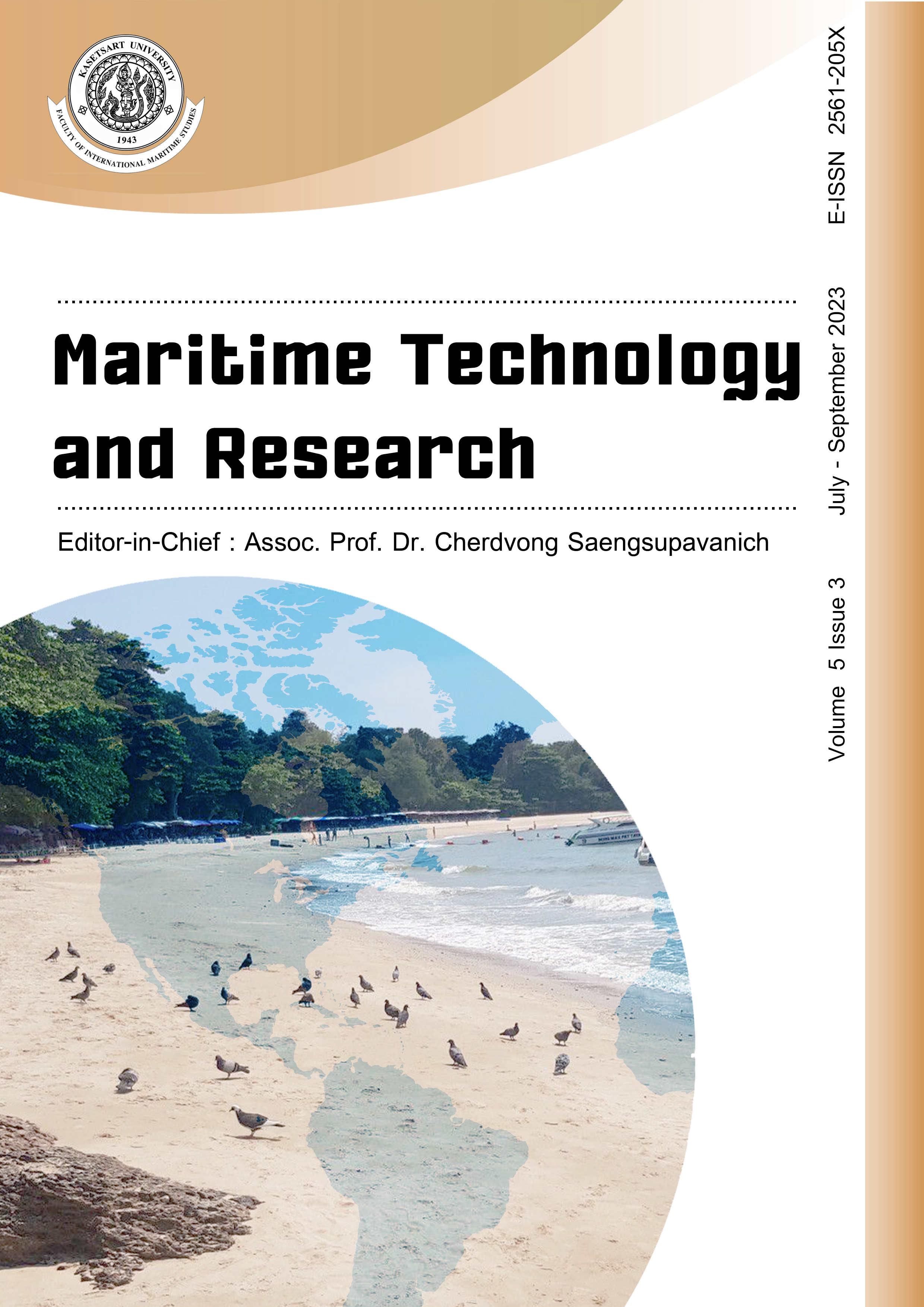Research on the effect of number of yard trucks on container terminal throughput
DOI:
https://doi.org/10.33175/mtr.2023.262975Keywords:
Container terminal, Yard throughput, Yard trucks, Truck terminals, Twenty-foot equivalent unitsAbstract
Container terminal productivity is a benchmark for the level of effectiveness of a container port. One indicator of container terminal productivity level can be calculated through yard throughput. Several factors affect yard throughput, one of which is the number of truck terminals. This study aims to investigate the effect of the number of truck terminals on yard throughput at a container terminal. The investigation was conducted using a container terminal simulation which was based on the discrete event simulation method. As a case study, a simulation of a container terminal with a dock length of 300 m with several quay cranes was two units. The simulation was done by parameters adding the number of truck terminals and variations in the capacity of ships coming. The results of the simulation show that an increase in the number of truck terminals affects the number of outputs, depending on the size of the loading and unloading vessels. From the simulation results obtained, the largest yard throughput capacity of 809 containers with the number of truck terminals is 8 units on a shipload of 1,000 twenty-foot equivalent units. The results of this study provide an overview of the needs of the truck terminal in the container terminal.
------------------------------------------------------------------------------
Cite this article: Riadi, A., Putra, G.L., Budiyanto, M.A. (2023). Research on the effect of number of yard trucks on container terminal throughput. Maritime Technology and Research, 5(3), 262975. https://doi.org/10.33175/mtr.2023.262975
------------------------------------------------------------------------------
Highlights
- The yard throughput of the container terminal has been investigated by a simulation model built based on a discrete event simulation
- The discrete event simulation has obtained the effect of increasing the number of truck terminals on the yard throughputs with container capacity variations from 200 - 1,000 TEUs
- The increase in speed at the truck terminal is insignificant to increase yard throughput and necessary to do integrated scheduling between the truck terminals, quay cranes, and gantry cranes
- The increase in the quay crane operation in container terminals will decrease the dwell time of container throughput
References
Bae, H. Y., Choe, R., Park, T., & Ryu, K. R. (2011). Comparison of operations of AGVs and ALVs in an automated container terminal. Journal of Intelligent Manufacturing, 22(3), 413-426. https://doi.org/10.1007/s10845-009-0299-1
Bish, E. K., Leong, T. Y., Li, C. L., Ng, J. W. C., & Simchi-Levi, D. (2001). Analysis of a new vehicle scheduling and location problem. Naval Research Logistics, 48(5), 363-385. https://doi.org/10.1002/nav.1024
Budiyanto, M. A., & Fernanda, H. (2020). Risk assessment of work accident in container terminals using the fault tree analysis method. Journal of Marine Science and Engineering, 8(6), 466. https://doi.org/10.3390/jmse8060466
Budiyanto, M. A., & Shinoda, T. (2017). Stack effect on power consumption of refrigerated containers in storage yards. International Journal of Technology, 8(7), 1182-1190. https://doi.org/10.14716/ijtech.v8i7.771
Budiyanto, M. A., & Shinoda, T. (2020). Energy efficiency on the reefer container storage yard: An analysis of thermal performance of installation roof shade. Energy Reports, 6, 686-692. https://doi.org/10.1016/j.egyr.2019.11.138
Budiyanto, M. A., Huzaifi, M. H., & Sirait, S. J. (2019). Estimating of CO2 emissions in a container port based on modality movement in the terminal area. International Journal of Technology, 10(8), 1618-1625. https://doi.org/10.14716/ijtech.v10i8.3508
Budiyanto, M. A., Nasruddin, & Zhafari, F. (2019). Simulation study using building-design energy analysis to estimate energy consumption of refrigerated container. Energy Procedia, 156, 207-211. https://doi.org/10.1016/j.egypro.2018.11.129
Budiyanto, M. A., Sunaryo, Fernanda, H., & Shinoda, T. (2019). Effect of azimuth angle on the energy consumption of refrigerated container. Energy Procedia, 156, 201-206. https://doi.org/10.1016/j.egypro.2018.11.128
Carlo, H. J., Vis, I. F. A., & Roodbergen, K. J. (2014). Transport operations in container terminals: Literature overview, trends, research directions and classification scheme. European Journal of Operational Research, 236(1), 1-13. https://doi.org/10.1016/j.ejor.2013.11.023
Fishman, G. S. (2001). Discrete-event simulation: Modeling, programming, and analysis. Springer. https://doi.org/10.1007/978-1-4757-3552-9
Günther, H. O., & Kim, K. H. (2006). Container terminals and terminal operations. OR Spectrum, 28(4), 437-445. https://doi.org/10.1007/s00291-006-0059-y
Huzaifi, M. H., Budiyanto, M. A., & Sirait, S. J. (2020). Study on the carbon emission evaluation in a container port based on energy consumption data. Evergreen, 7(1), 97-103. https://doi.org/10.5109/2740964
Li, C. L., & Vairaktarakis, G. L. (2004). Loading and unloading operations in container terminals. IIE Transactions, 36(4), 287-297. https://doi.org/10.1080/07408170490247340
Liu, C. I., Jula, H., & Ioannou, P. A. (2002). Design, simulation, and evaluation of automated container terminals. IEEE Transactions on Intelligent Transportation Systems, 3(1), 12-26. https://doi.org/10.1109/6979.994792
Moffatt & Nichol. (2020). FlexSim CT is now FlexTerm. Utah, USA: FlexSim.
Park, Y. M., & Kim, K. H. (2003). A scheduling method for Berth and Quay cranes. OR Spectrum, 25(1), 1-23. https://doi.org/10.1007/s00291-002-0109-z
Rijsenbrij, J. C., & Wieschemann, A. (2011). Sustainable container terminals: A design approach. Operations Research/Computer Science Interfaces Series, 49(1), 61-82. https://doi.org/10.1007/978-1-4419-8408-1_4
Statista Research Department. (2020). Container shipping: Statistics & facts, statista. Retrieved from https://www.statista.com/topics/1367/container-shipping
Veenstra, A., Zuidwijk, R., & Asperen, E. V. (2012). The extended gate concept for container terminals: Expanding the notion of dry ports. Maritime Economics & Logistics, 14(1), 14-32. https://doi.org/10.1057/mel.2011.15
Vis, I. F. A., & Koster, R. D. (2003). Transshipment of containers at a container terminal: An overview. European Journal of Operational Research, 147(1), 1-16. https://doi.org/10.1016/S0377-2217(02)00293-X
Wilmsmeier, G., Tovar, B., & Sanchez, R. J. (2013). The evolution of container terminal productivity and efficiency under changing economic environments. Research in Transportation Business & Management, 8, 50-66. https://doi.org/10.1016/j.rtbm.2013.07.003
Yang, Y. C., & Lin, C. L. (2013). Performance analysis of cargo-handling equipment from a green container terminal perspective. Transportation Research Part D: Transport and Environment, 23, 9-11. https://doi.org/10.1016/j.trd.2013.03.009
Zangwa, A. I. (2018). A total factor productivity analysis of a container terminal, Durban, South Africa (Doctoral dissertations). Malmö, Sweden: World Maritime University.
Zhang, C., Wan, Y. W., Liu, J., & Linn, R. J. (2002). Dynamic crane deployment in container storage yards. Transportation Research Part B: Methodological, 36(6), 537-555. https://doi.org/10.1016/S0191-2615(01)00017-0
Downloads
Published
Issue
Section
Categories
License
Copyright (c) 2023 Maritime Technology and Research

This work is licensed under a Creative Commons Attribution-NonCommercial-NoDerivatives 4.0 International License.
Copyright: CC BY-NC-ND 4.0








